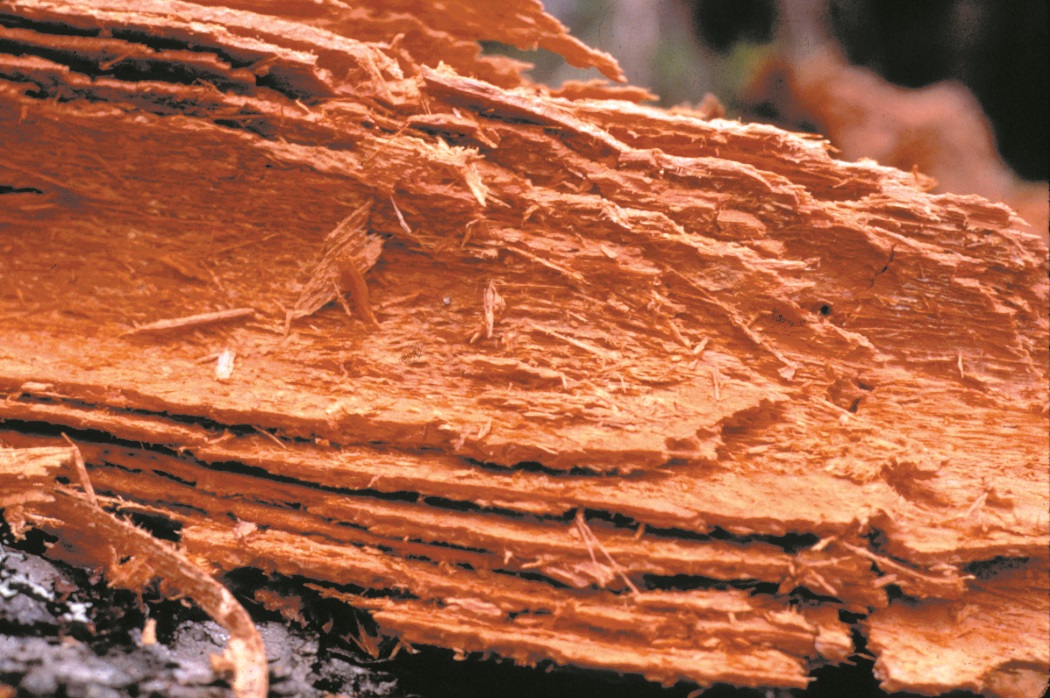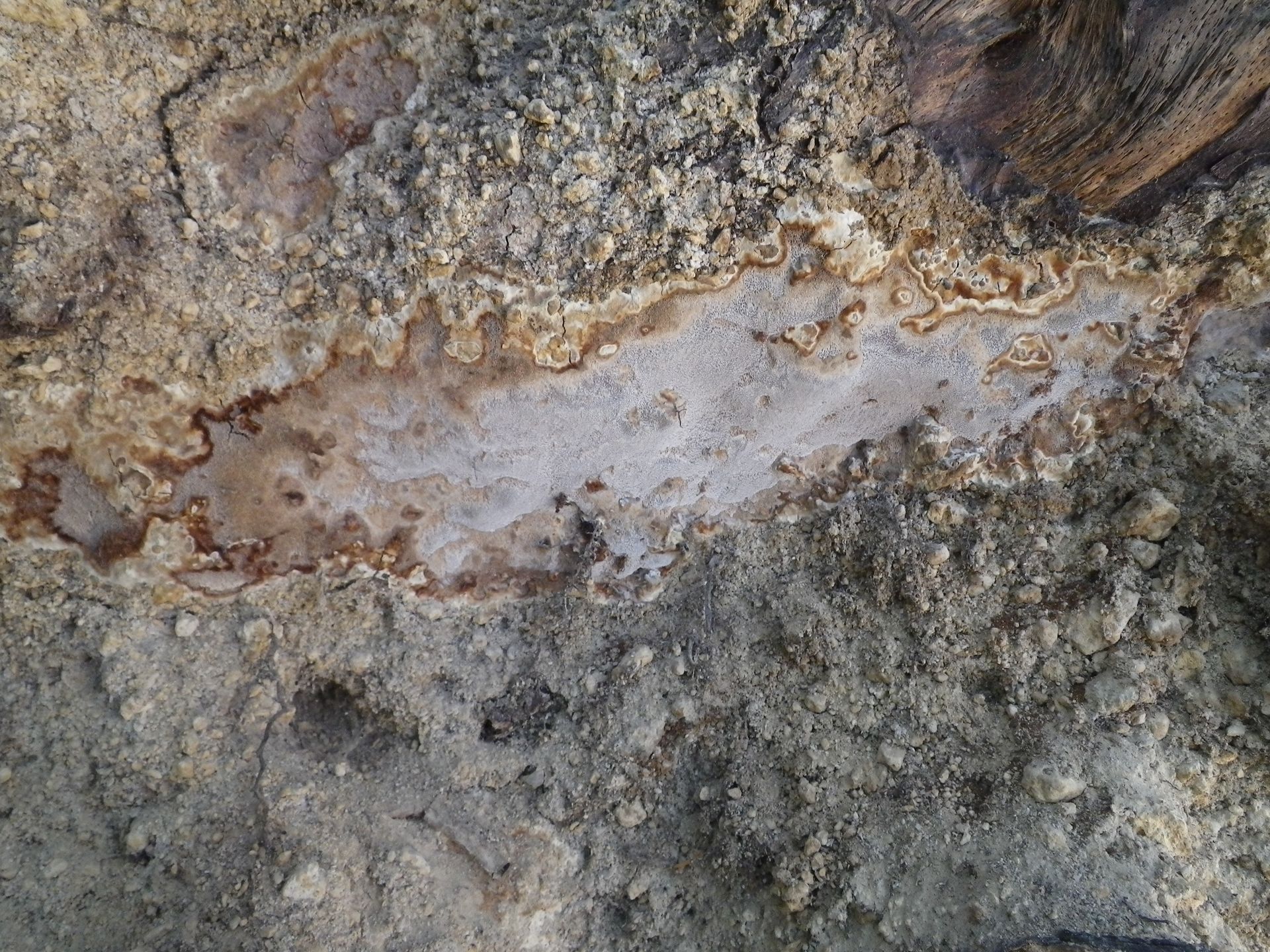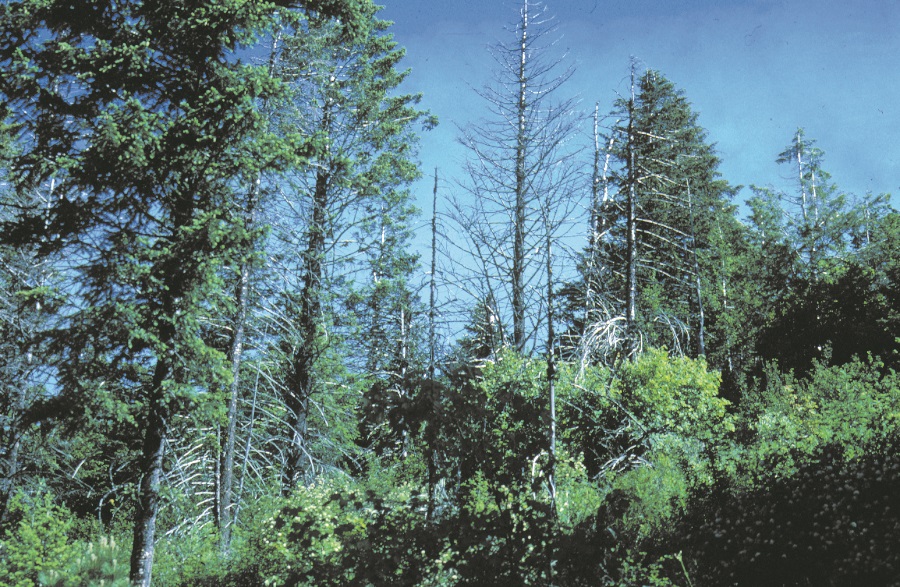Laminated Root Rot
Coniferiporia sulphurascens
Key Wildlife Value:
Laminated root rot creates short-term snags of any size and all sizes of down wood, by killing or decaying the root system and butts of host trees. It can create trees with hollow butts, which may continue to provide habitat when they fall. Concentrations of down wood, useful habitat for many species of wildlife, are likely to occur in laminated root rot infection areas, usually with a corresponding decrease in canopy cover. Canopy gaps created by laminated root rot expand slowly, resulting in a more diverse stand structure and at times a more diverse plant species composition, as resistant or non-host trees, shrubs, and forbs are released or become established from the infection center outward, following the slowly expanding fringe of dying host trees. Bark beetles and woodborers frequently are attracted to trees infected with root disease, providing good foraging habitat for woodpeckers.
Distribution in Oregon and Washington:
Found throughout Washington. In Oregon, present west of the Cascades, on the Cascades crest, and north of the Crooked River on the east side of the Cascades. (See also Important Habitats and Spread Dynamics).
Hosts:
Douglas-fir, mountain hemlock, grand fir, and white fir are often killed. Other tree species vary in susceptibility and degree of tolerance (Table.fid-2). Hardwoods are immune.
Diagnosis:
Advanced decay probably provides the best diagnostic features for identification of laminated root rot. Advanced decay is yellow and laminated (wood separates at the growth rings) with small rounded to somewhat oval pitting on both sides of the laminae.

Freshly cut wood may have incipient decay characterized by a reddish-brown to chocolate-brown stain present in the outer heartwood and sapwood. When viewed on a freshly cut stump or cross-section of trunk surface, the staining is often irregularly crescent-shaped to semi-circular, roughly following along the curvature of affected growth rings, and usually appears in the outer half of the stump radius.


In young stands regenerated following harvest activities, look for a pattern of dead or missing trees associated with large stumps. Stumps may have hollows or evident laminated decay. In more mature stands, look for patches of forest that have a more open canopy than the surrounding stand and that contain windthrown trees that are broken at the base or that have decayed roots or “rootballs” with characteristic decay caused by C. sulphurascens.


Bark beetles, especially Douglas-fir beetle, Douglas-fir engraver, Douglas-fir pole beetle, and fir engraver, frequently colonize trees infected with laminated root rot.
Life History:
Laminated root rot infects new hosts when uninfected roots of susceptible trees grow into contact with infected stumps or roots. The ectotrophic mycelium of C. sulphurascens grow across the root contacts and invade healthy roots. Fungal growth inside infected root tissues causes progressive wood decay and death of living cells in the heartwood and sapwood, resulting in reduced uptake of nutrients and water and weakened structural support to the aboveground portion of the tree. Infected trees usually fall over while still green, frequently before developing obvious crown symptoms, or die standing. Once infected trees die, the fungus continues to live on-site as a saprophyte in small roots for 8 years or more, and in large stumps and large roots for as long as 50 years. Infection by wind-dispersed spores is thought to play a relatively unimportant role in the life cycle and spread of C. sulphurascens.
Most fires have little effect on the survival of C. sulphurascens on a site. Only those fires intense enough to destroy entire root systems are detrimental, and such intense fires usually also damage the soil. Fire, however, does influence species composition, and generally tends to favor site occupancy by immune and less-susceptible species, reducing the expression and expansion of disease.
Important Habitats and Spread Dynamics:
C. sulphurascens is nearly ubiquitous throughout most Douglas-fir and grand fir forests in Oregon and Washington. It is particularly prevalent, commonly causing large infection centers, west of the Cascade Mountains and on the Cascades crest. In drier eastside types, laminated root rot is commonly found on north-facing slopes and stream bottoms, although it may also occur in other locations. Very large, circular infection centers (up to 40 ha, or 100 ac) are found in mountain hemlock stands in the high Cascade Mountains of central Oregon. This fungus depends for its survival upon the connected roots of live host trees and the dead underground portions of infested roots and stumps, especially large ones. It does not appear to be restricted by climatic or site conditions, or influenced by tree vigor-enhancing treatments such as thinning or fertilization. Continuous cover of highly susceptible species provides favorable habitat for C. sulphurascens, especially when large infected stumps are also present. Laminated root rot usually intensifies when infection centers and adjacent areas are regenerated with highly susceptible species.
Laminated root rot spreads primarily through root-to-root contact between infected and uninfected host trees. It does not spread through uncolonized dead wood, but may infect a live root that grows into contact with infected dead wood. It successfully infects host trees regardless of their vigor. There appears to be no reliable method of long-distance spread. Crown symptoms may appear within 5 to 15 years following initial infection, and larger trees live an average of 10 years after the onset of crown symptoms. Seedlings planted into inoculum may die within the first year. Colonized stumps and infected trees serve as “centers” of gradually expanding root disease infection areas as the fungus slowly moves down colonized tree roots and up the roots of previously uninfected individuals. Infection centers expand at a rate of about 30 cm (12 in) per year. The distribution of infection centers may be diffuse, with diseased individuals or small groups of 2 to 3 trees occurring scattered throughout the area of infection, or discrete, with discernable margins marking the transition from aggregations of diseased trees to healthy forest.
The ability of laminated root rot to survive in a location and to spread is influenced by the abundance, density and spatial arrangement of susceptible host species, the size of infected trees and stumps, and the amount of time since the site was occupied by living susceptible hosts. Because laminated root rot is able to persist on a site for very long periods, it may be considered a permanent resident unless suppressive management actions are undertaken to ensure either the removal of inoculum or the absence of host trees for at least 50 years.
Opportunities for Manipulation to Increase Wildlife Habitat:
Disease centers and some surrounding non-infected area may be retained to provide a continuing supply of short-term snags and down wood. In managed stands having a high proportion of uninfected host species outside and surrounding the disease centers, it is desirable to buffer the disease centers (including some surrounding non-infected area) to prevent spread into the remaining host trees.Non-host buffers may require periodic maintenance to remove host species ingrowth so that unintended spread of the root disease into other areas of the stand does not occur. This approach would be appropriate for stands where root disease infection centers were discreet and not diffuse, and for stands being converted to non-host species.
Potential Adverse Effects:
Laminated root rot can cause undesired reductions in stand densities by causing high levels of mortality, and may limit the species of trees that can be grown to a large size on a site. It causes significant losses in growth. Ground fire severity may increase as a result of the abundant down wood in infection areas. On recreational and administrative sites, forest work sites, and along roadsides, trees with laminated root rot have a high potential for failure and can present a significant safety hazard.
How to Minimize the Risk of Adverse Effects:
Several management approaches are available for minimizing the adverse effects of laminated root rot. The most opportune time to apply most strategies occurs during final harvest and stand regeneration activities, although, depending the strategy selected, helpful actions also may be undertaken at other times.
One approach involves favoring less susceptible and immune species on sites infected with laminated root rot. This approach does not eliminate the pathogen from the site because the fungus continues to survive on the less susceptible species, but reduces the effects of disease upon the stand. This approach is usually preferred on heavily infested sites, because it is generally cost effective, and maintains conifer cover on the site. Less susceptible and immune species may be planted when a stand is regenerated, or they may be favored during intermediate entries such as thinning and partial cutting.
A second approach is to create a buffer between an expanding laminated root rot infection center and the adjacent portion of the stand that is judged to be healthy. This may be accomplished in several ways, from complete removal of trees for a prescribed distance, usually 15 m, surrounding the center, to removing only host trees from the buffer area. This approach requires accurate information on the spatial distribution of the root disease in the stand, obtained by conducting a root disease survey, before implementation is considered, and is appropriate only in situations where distribution of the fungus is discreet and not diffuse. To be effective, host trees that seed in following initial treatment should be periodically removed from the buffer area during subsequent management activities, e.g., precommercial thinning.
A third approach is to attempt to eliminate the pathogen from the site. This may be accomplished either preventing the growth of host tree species until the pathogen has died out or by removing inoculum from the site. The first strategy, preventing the growth of host tree species until the pathogen dies, limits site occupancy to immune species, such as various hardwoods, for a period of 50 years or more. West of the Cascades crest, red alder, which has been hypothesized to function as a natural biological control of laminated root rot, has most commonly been used in this capacity, because it can quickly occupy the site after being planted, effectively preventing susceptible conifer species from growing, while also providing commercial products. A possible disadvantage to this strategy, depending on management objectives, is the long period of time that conifers must be excluded from the site in order for the strategy to be effective. Periodic entries to remove host species ingrowth may be required to maintain effectiveness. The other strategy, inoculum removal (stump and root removal) has been shown to be effective, but is expensive and involves intense use of heavy equipment, which carries a risk of significant negative effects upon the soil and subsequent tree growth.
On recreational and administrative sites, forest work sites, and along prioritized roadsides, infected trees within striking distance of a target should be removed or topped to a safe height, or the situation arranged so that people are not exposed to danger.
References
Goheen, E.M. and E.A. Willhite. 2006. Field guide to common diseases and insect pests of Oregon and Washington conifers. USDA Forest Service, Pacific Northwest Region, Portland, OR. R6-NR-FID-PR-01-06. 335 pp. http://www.biodiversitylibrary.org/bibliography/80321#/summary
Filip, G.M., J. Brio, K.L. Chadwick, D.J. Goheen, E.M. Goheen, J.S. Hadfield, A. Kanaskie, H.S.J. Kearns, H.M. Maffei, K.M. Mallams, D.W. Omdal, A.L. Saavedra, and C.L. Schmitt. 2014. Field guide for hazard-tree identification and mitigation on developed sites in Oregon and Washington forests. USDA Forest Service, Pacific Northwest Region, Portland, OR. R6-NR-TP-021-2013. 120 pp.
Hadfield, J.S., D.J. Goheen, G.M. Filip, C.L. Schmitt, and R.D. Harvey. 1986. Root diseases in Oregon and Washington conifers. USDA Forest Service, Pacific Northwest Region, Portland, OR. R6-FPM-250-86. 27 pp.
Nelson, E.E., N.E. Martin, and R.E. Williams. 1981. Laminated root rot of western conifers. Forest Insect and Disease Leaflet 159 (revised). USDA Forest Service, Washington, D.C. 6 pp.
Thies, W.G. and R.N. Sturrock. 1995. Laminated root rot in western North America. Gen. Tech. Rep. PNW-GTR-349. USDA Forest Service, Pacific Northwest Research Station, Portland, OR. 32 pp. http://www.srs.fs.fed.us/pubs/viewpub.jsp?index=3065
Website links
General Technical Report PNW-GTR- 349, Laminated root rot in western North America